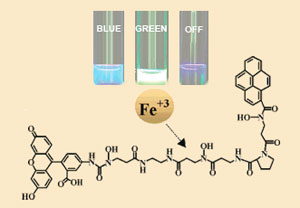
Israeli scientists have come up with the ultimate in small-scale security:, a molecule that can act as an electronic keypad lock like the ones in home security. This process give new heights to small scale safety measures and has the potential of providing unbreakable security. The molecule lock, resembling an iron binding compound secreted by special bacteria, ‘unlocks’ when exposed to a smart combination of two chemicals and UV Light, giving out florescence as a signal. The molecule consists of pyrene and fluorescein linked by an iron-binding segment. The molecule lights up green or blue in response to the correct passwords and fluoresces dimly if the same inputs are introduced in a different order(wrong password). Moreover, the molecule would lock-up upon failed retries and block any further attempts at breaking it.
As acid, base, and irradiating UV light are introduced at three minute intervals, the molecule jumps between various charged states. The result, report researchers at the Weizmann Institute, Rehovot, is that the sequence ‘acid-base-light’ makes the molecule fluoresce green, while a separate input ‘acid-light’ gives a blue fluorescence. Any other sequence input gives dim light or none at all. This behaviour, says co-author Abraham Shanzer, mimics an electronic keypad lock. The device lights up only when the correct chemical ‘passwords’ are introduced.

Basic Molecule Structure
"By harnessing the principles of molecular Boolean logic, we have designed a molecular device that mimics the operation of an electronic keypad, a common security circuit used for numerous applications in which access to an object or data is to be restricted to a limited number of persons," the researchers state. "The development of a molecular-scale keypad lock is a particularly attractive goal as it represents a new approach to protecting information at the molecular scale."

How the molecular keypad lock works
A significant application to this lock might be to recognize when certain sequences of chemicals are released in the body—for instance, after exposure to Sarin or another deadly chemical including various biological weapons and allow safeguard triggers.
Note: This story has been adapted from a news release issued by American Chemical Society, Science Daily, Live Science and Scientific American.